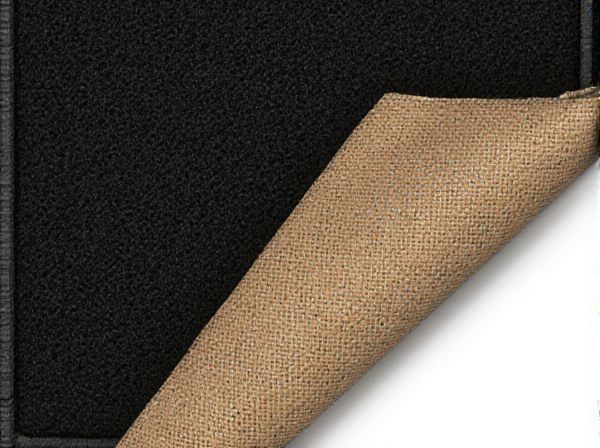
Photo illustration: Latex Backing vs Jute Backing
Latex backing offers superior moisture resistance and durability, making it ideal for areas prone to spills or high foot traffic. Jute backing provides an eco-friendly, natural option with excellent breathability but may lack the longevity and water resistance of latex. Your choice depends on the balance you need between sustainability and performance in carpet backing.
Table of Comparison
| Feature | Latex Backing | Jute Backing |
|---|---|---|
| Material | Synthetic rubber (Latex) | Natural fiber (Jute) |
| Durability | High resistance to wear and moisture | Moderate, prone to moisture damage |
| Water Resistance | Excellent water resistance | Poor water resistance |
| Grip | Strong anti-slip properties | Moderate grip |
| Comfort | Soft and flexible base | Firm and rough texture |
| Environmental Impact | Non-biodegradable, synthetic | Biodegradable and eco-friendly |
| Cost | Generally higher price | More affordable option |
| Ideal Use | Wet environments, heavy use cars | Dry climates, light to moderate use |
Introduction to Carpet Backing Materials
Latex backing provides a durable, flexible, and moisture-resistant foundation widely used in residential and commercial carpet installations, enhancing carpet stability and lifespan. Jute backing, derived from natural fibers, offers an eco-friendly, breathable, and biodegradable alternative primarily favored for traditional or natural fiber carpets. Selecting between latex and jute backing depends on factors such as carpet type, installation environment, and desired durability.
What is Latex Backing?
Latex backing is a synthetic rubber coating applied to the back of rugs and carpets to provide non-slip properties, durability, and moisture resistance. It enhances the grip on hard floors, preventing rugs from shifting and extending the product's lifespan by protecting against wear and tear. Latex backing is favored for its flexibility, ease of cleaning, and ability to maintain rug shape without causing floor damage.
What is Jute Backing?
Jute backing refers to a natural fiber woven material made from the jute plant, commonly used as a durable and eco-friendly backing for rugs and carpets. It offers strong support and breathability, enhancing the rug's longevity while being biodegradable and sustainable compared to synthetic alternatives like latex backing. Jute backing is favored for its organic texture and ability to provide a non-slip foundation without harmful chemicals.
Key Differences Between Latex and Jute Backing
Latex backing offers superior durability and moisture resistance compared to jute backing, making it ideal for high-traffic areas and damp environments. Jute backing, derived from natural fibers, provides better eco-friendliness and traditional appearance but lacks the resilience to water and heavy wear. The choice between latex and jute backing depends on the required balance of durability, environmental impact, and application setting.
Durability and Longevity Comparison
Latex backing offers enhanced durability with its superior resistance to moisture, wear, and tear, making it ideal for high-traffic areas and prolonged use. Jute backing, while eco-friendly and biodegradable, is more susceptible to deterioration when exposed to moisture and heavy foot traffic, limiting its lifespan. Rugs with latex backing typically exhibit greater longevity and maintain structural integrity better than those with jute backing over time.
Comfort and Underfoot Feel: Latex vs Jute
Latex backing offers superior cushioning and resilience, providing a soft yet supportive underfoot feel that enhances overall comfort. Jute backing, being natural and firmer, tends to deliver a rougher texture and less bounce, which may feel harder underfoot over time. For those prioritizing plush comfort and durability, latex backing is often preferred, while jute is favored for eco-friendliness and traditional appeal.
Environmental Impact and Sustainability
Latex backing offers strong durability and biodegradability, making it an environmentally friendly choice that reduces landfill waste compared to synthetic alternatives. Jute backing, derived from natural fibers, is renewable and compostable, supporting sustainable agriculture and lowering carbon footprints through its minimal processing requirements. Both materials contribute to eco-conscious flooring options, but jute holds an advantage in renewability while latex excels in longevity and resilience.
Cost Analysis: Latex Backing vs Jute Backing
Latex backing typically incurs higher initial costs due to synthetic material processing and specialized adhesive application, while jute backing offers a more affordable option derived from natural fibers with lower production expenses. Over time, latex backing may provide better durability and moisture resistance, potentially reducing replacement frequency and maintenance costs compared to jute backing, which absorbs moisture and may degrade faster. Cost analysis must factor in both upfront investment and long-term performance to determine overall value between latex and jute-backed products.
Maintenance and Cleaning Requirements
Latex backing offers superior resistance to moisture and stains, making it easier to clean with mild soap and water without damaging the material. Jute backing requires more careful maintenance since exposure to water can cause mold growth and deterioration, necessitating dry cleaning or spot treatments to preserve its integrity. Choosing latex backing can reduce overall cleaning frequency and extend carpet lifespan in high-traffic or moisture-prone areas.
Choosing the Right Backing for Your Space
Latex backing offers excellent moisture resistance and durability, making it ideal for high-traffic areas and spaces prone to spills, such as kitchens and bathrooms. Jute backing provides a natural, breathable option that enhances comfort and eco-friendliness but may absorb moisture, best suited for low-moisture environments like bedrooms and living rooms. Evaluating the room's humidity levels, foot traffic, and environmental impact will help determine the most suitable backing choice for your flooring needs.
 caratoz.com
caratoz.com